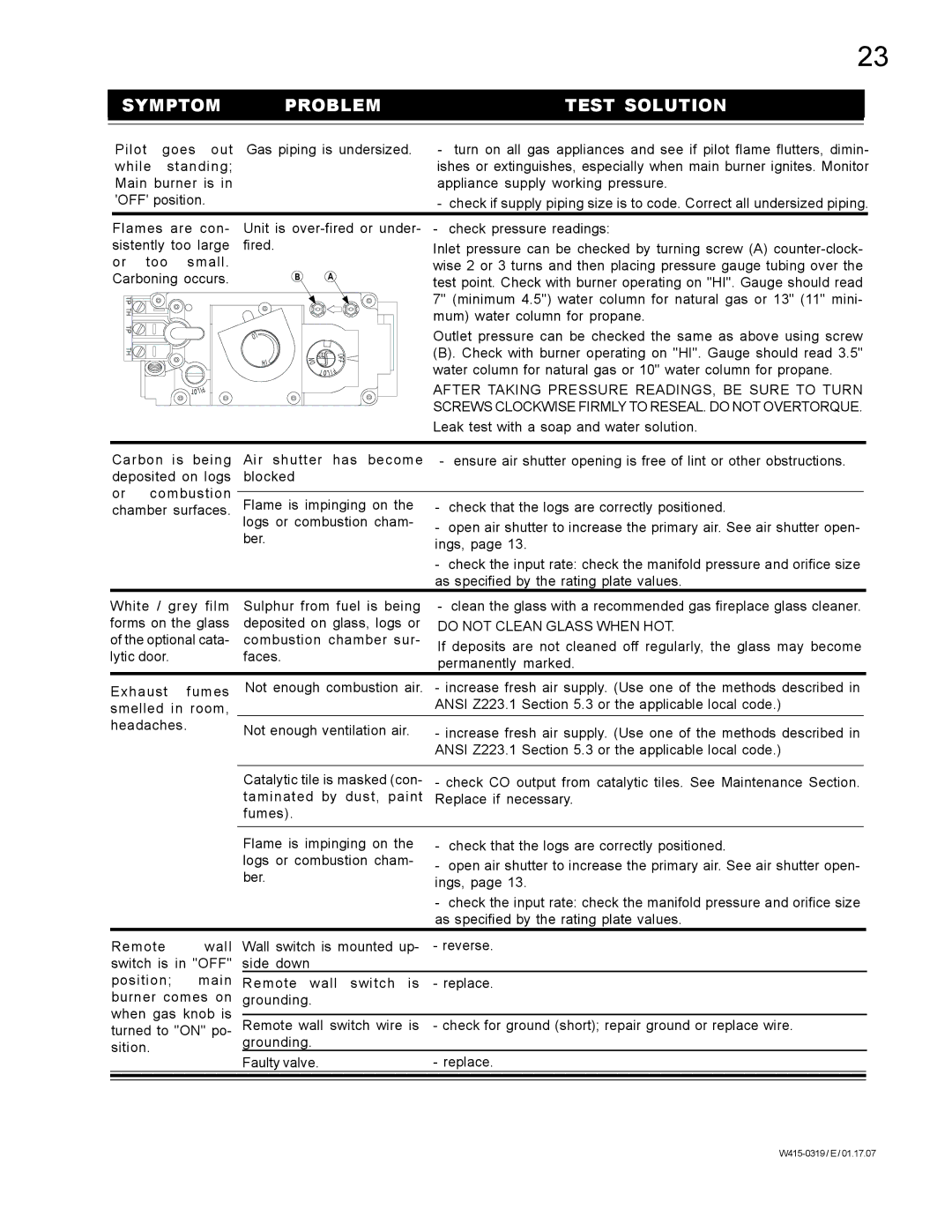
23
SYMPTOM | PROBLEM | TEST SOLUTION |
|
|
|
Pilot goes out Gas piping is undersized. while standing;
Main burner is in 'OFF' position.
Flames | are con- | Unit is | ||
sistently too large | fired. |
|
| |
or too | small. |
|
|
|
Carboning occurs. |
| B | A | |
|
| OL |
|
|
|
|
| N | O |
|
|
| F | |
|
| HI | O | F |
|
|
| IP | |
|
|
|
| |
|
|
|
| TOL |
| IP |
|
|
|
| TOL |
|
|
|
- turn on all gas appliances and see if pilot flame flutters, dimin- ishes or extinguishes, especially when main burner ignites. Monitor appliance supply working pressure.
-check if supply piping size is to code. Correct all undersized piping.
-check pressure readings:
Inlet pressure can be checked by turning screw (A)
Outlet pressure can be checked the same as above using screw
(B). Check with burner operating on "HI". Gauge should read 3.5" water column for natural gas or 10" water column for propane.
AFTER TAKING PRESSURE READINGS, BE SURE TO TURN SCREWS CLOCKWISE FIRMLY TO RESEAL. DO NOT OVERTORQUE.
Leak test with a soap and water solution.
Carbon is being | Air shutter has become | - | ensure air shutter opening is free of lint or other obstructions. | |
deposited on logs | blocked |
|
| |
or | combustion |
|
|
|
Flame is impinging on the | - | check that the logs are correctly positioned. | ||
chamber surfaces. | logs or combustion cham- | - | open air shutter to increase the primary air. See air shutter open- | |
|
| ber. | ||
|
| ings, page 13. | ||
|
|
| ||
-check the input rate: check the manifold pressure and orifice size as specified by the rating plate values.
White / grey film | Sulphur from fuel is being | - | clean the glass with a recommended gas fireplace glass cleaner. | ||
forms on the glass | deposited on glass, logs or | DO NOT CLEAN GLASS WHEN HOT. | |||
of the optional cata- | combustion chamber sur- | If deposits are not cleaned off regularly, the glass may become | |||
lytic door. | faces. | ||||
permanently marked. | |||||
|
| ||||
Exhaust fumes | Not enough combustion air. | - increase fresh air supply. (Use one of the methods described in | |||
smelled in room, |
| ANSI Z223.1 Section 5.3 or the applicable local code.) |
| ||
headaches. | Not enough ventilation air. | - increase fresh air supply. (Use one of the methods described in | |||
| |||||
|
| ANSI Z223.1 Section 5.3 or the applicable local code.) | |||
|
|
|
| ||
| Catalytic tile is masked (con- | - check CO output from catalytic tiles. See Maintenance Section. | |||
| taminated by dust, paint | Replace if necessary. | |||
| fumes). |
|
|
| |
| Flame is impinging on the | - | check that the logs are correctly positioned. | ||
| logs or combustion cham- | - | open air shutter to increase the primary air. See air shutter open- | ||
| ber. | ||||
| ings, page 13. | ||||
|
| ||||
-check the input rate: check the manifold pressure and orifice size as specified by the rating plate values.
Remote | wall | Wall switch is mounted up- | - reverse. | |
switch is in "OFF" | side down |
| ||
position; | main | Remote wall switch is | - replace. | |
burner comes on | grounding. |
| ||
when gas knob is |
|
| ||
Remote wall switch wire is | - check for ground (short); repair ground or replace wire. | |||
turned to "ON" po- | ||||
sition. |
| grounding. |
| |
| Faulty valve. | - replace. | ||
|
| |||
|
|
|
| |
|
|
|
| |
